#norman medieval fair
Explore tagged Tumblr posts
Text
Clothing of the 14th Century: an unreasonably deep dive
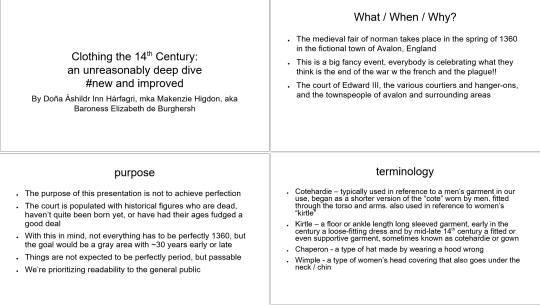

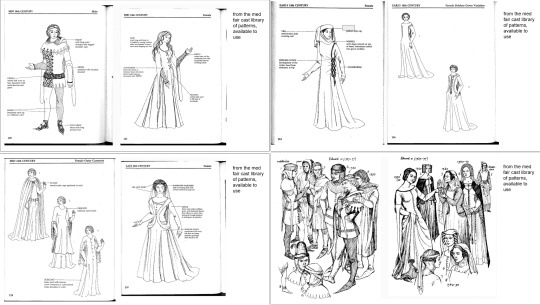

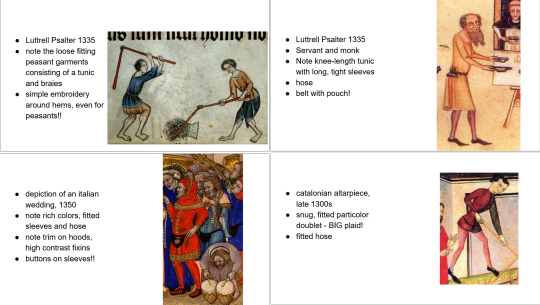
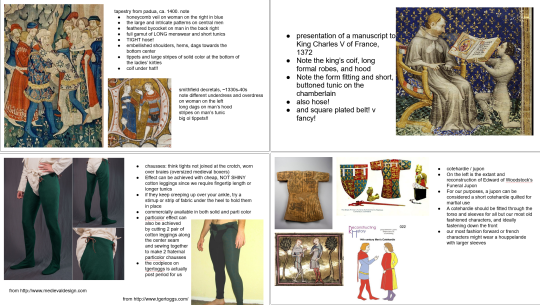

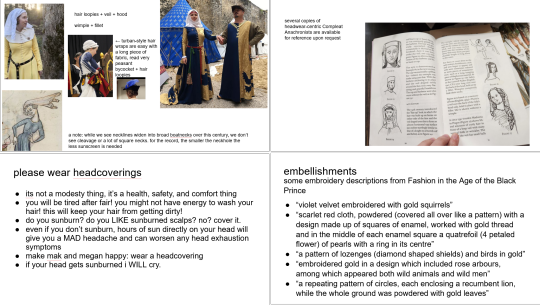
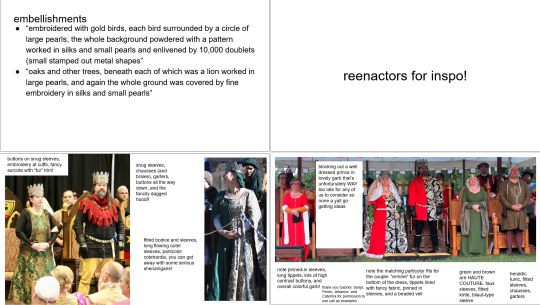
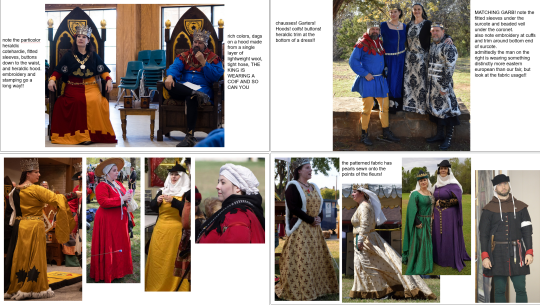
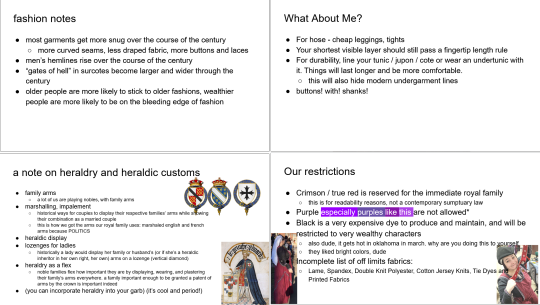


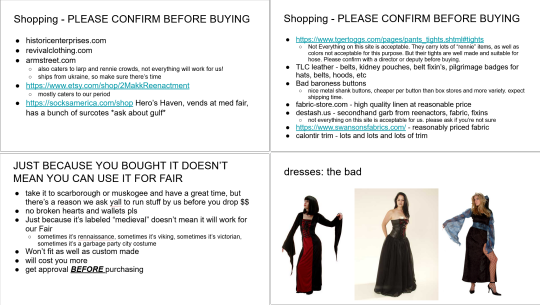


Hosting the costuming presentation for the Norman Medieval Fair on this blog so it can be shared to the mailing list.
#arts & sciences#a&s#sca#society for creative anachronism#nmf#norman medieval fair#historical costuming
203 notes
·
View notes
Text

There's a pretty sizable travel load for the year, and more still to possibly be added! My husband will be more prevalent as well, as he'll be covering me for weekends I'm busy with Topsy Turvy Show this year where able. ✨🌟✨
#art#small artist#artist alley#artist support#megacon#magfest#amke#anime milwaukee#planet comiccon#norman medieval fair#origins game fair#gen con#metro con#twin cities con#galaxy con columbus#anime#fan art#original art#digital artist#arte
11 notes
·
View notes
Text
The Starks and the Boltons = The Percys and The Nevilles
GRRM is known to draw inspiration from real life history for ASOIAF. He confirmed that houses Lannister and Stark are inspired by Lancaster and York, the two Plantagenet branches that waged war for the english crown in the 15th century. But I think another inspiration (and way closer parallel) that tends to be missed is that of House Percy, and how they were basically the english Starks.
The Percys were at the heart of northern identity and politics. They held the Earldom of Northumberland and Bamburgh Castle, a land and seat that were bathed in a very, very long history of anglo-saxon kingship, as Northumberland was once the capital of the Kingdom of Northumbria, ruled by the House of Bebbanburg from Bamburgh Castle, and Northumbria's territory was composed of basically all of northern England! Because of this symbolic holding and their land power, the Percys were almost seen as Kings in the North (unoficially of course). I should point out that the northern medieval english were closer to their anglo-saxon roots ethnically and genetically, unlike the south which adopted more Norman customs and blood when William the Conqueror did his thing in 1066. So, a signicant connection to that past mattered a lot in the North.
There was even a phrase in northern England, which was this:
'The North knows no Prince but a Percy'.
I don't think I need to say which phrase this one inspired in the world of ASOIAF.
I would also like to add that the Percy sigil was a wild animal of a cold color, here it is:

Now, let's look at the Nevilles. They were also a northern family that rose to prominence when they became the Earls of Westmorland. This was okay at first for the Percys since they were older and held Bamburgh Castle, but the Nevilles were grasping and soon they started gaining more lands through strategic marriages, absorbing two Earldoms in the south of England and gaining many lands in the North as well, some of which were under Percy domain. But things got even worse when Cecily Neville was married to the Duke of York, cousin to the King of England, and her nephew Richard Neville installed her son, Edward IV, as the new King after the first stages of the Wars of the Roses (York vs Lancaster) took place. The new royal family became the House of York, whose King was half Neville, the House also mainly responsable for the yorkist victory.
Meanwhile, the Percys were lancastrians, and they payed the price for that. Edward IV stripped the Percys from the title of Earls of Northurmberland and gave it to a Neville man, making this family (for a time) the new main power in the North.
So we have a northern family taking the north of England with support from the royal family, and so, the southern political regime in general. Now take a look at the sigil of House Neville:

Looks familiar? Red? A cross? GRRM really is a history buff, pouring it into his books and making it cuntier in the process. I mean a bloody flayed man is way cooler for a sigil than a boring white cross.
But to be fair, the Nevilles weren't brutal tyrants like the Boltons, they were just very scheming and opportunistic, favoring southern intrigue rather than northern warring. Taking this into account, and taking into account how independent and wary of southron interference the northern englishmen were, it would be interesting to think about how would have the Nevilles faired if the successfully managed to take the North in a permanent way (they lost Northumberland pretty quickly because of the backlash of the northern nobility to them replacing the Percys and the defeat of House York at the hands of the Tudors).
#Sorry for any typos#asoiaf#asoiaf fandom#a song of ice and fire#game of thrones#westeros#winterfell#house stark#house bolton#house lannister#english history#medieval england#medieval english history#the wars of the roses#the cousin's war#15th century england#historical#medieval fantasy#house of percy#house of neville#the white queen#the white princess#house of york#house of lancaster#edward iv#Henry VI#cecily neville#richard duke of york
27 notes
·
View notes
Text

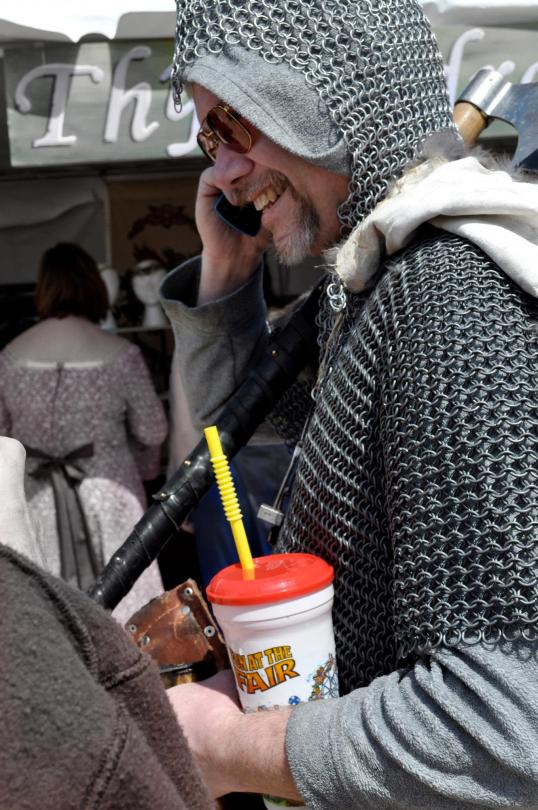
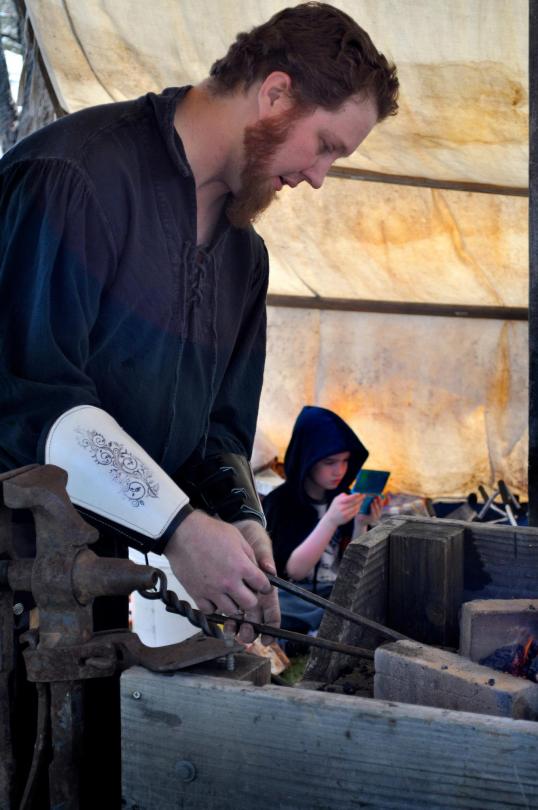
some fun anachronistic photos I took at the 2013 Medieval Fair in Norman, Oklahoma.
8 notes
·
View notes
Text
Hey! I've updated my OC Elspeth's about page and I'm re-adding two more muses: Indeg and Amhar
I've had some issues writing Indeg in the past and that's mostly because there's so little on her and everything written or said about Arthurian Lore is Canon so building something up can be hard.
Since she's written in myth as either :
from the middle east, is Jewish, and is the wife of Sir Morien which this telling seems to have the most info on her character( but puts Arthur in a very shady light).
In Culhwch and Olwen she is briefly described as one of the Gold Torqued Women of the Isle and a is requested bride of Culhwch as a prize. Arthur vehemently denies this because she is his mistress and because she's Jewish. ( tho Culhwch's several brief mentions of the struggle of finding "Indeg's Equal" is hilarious).
"Arthurian References in Medieval Welsh Poetry, c. 1100 – c. 1540" briefly mentions that there is a poem that is alluded to in other works regarding Arthur's wooing of Indeg, but it hasn't survived beyond the fact that she was the most beautiful woman in all of Briton and that her religion was an issue.
I've been reading into the Arthurian romance Viduvilt and this time around I don't want to remove Indeg's religion from her. I don't think that's fair to what little survives of her character.
Given Arthur's known religious intolerance in a lot of works this just seems important. Now my Catholic self doesn't know anything about Judiasm but I sure can try and learn.
for instance the Jewish people first came to England shortly after the Norman Conquest of 1066 from Spain, Italy, and Russia ( which fits perfectly with Arthur's Roman conquest!). I've also found that Jewish people and everything they owned were considered to be the property of the king. They were only allowed to stay at the permission of the king which left them open to significant exploitation by the Crown. Considering that Arthur had eleven Golden Torqued Women of the Isle, this also makes sense if she was one of them since a Torque is a permanent collar.
All of this makes Amhar's rebellion against Arthur make a little more sense to me as well.
2 notes
·
View notes
Text
Katherine of York:
[Henry VIII's] fondness for his aunt was once again demonstrated when in 1512 he granted Katherine all the Courtenay estates in Devon for the term of her life, and to be passed to her children upon her death. This act gave Katherine her much needed security, although did she have to make a sacrifice to pay for it? For shortly after William’s death, Katherine took the following vow of chastity:
In the name of the Father, the Son, and the Holy Ghost, I, Katherine Courtneye, Countess of Devonshire, widow, and not wedded, ne unto any man assured, promise and make a vow to God, and to our Lady, and to all the Company of Heaven, in the presence of you, worshipful Father in God, Richard, Bishop of London, for to be chaste of my body, and truly and devoutly shall keep me chaste, for this time forward, as long as my life lasteth, after the rule of St Paul. In nomine Patris et Filii et Spiritus Sancti
The romantic perspective of course is that she took the vow because she deeply loved her husband and had come to a decision that she did not want to marry anyone else. This may well have been the case. But there is also a hypothesis that perhaps this vow may have either been a condition of Henry’s grant to her, or a condition Katherine placed upon herself to keep her lands and property safe. As the daughter of a Yorkist King, as much as Henry had a real regard for her, he may not have felt the same about any future man that she may have chosen to marry. There is no proof that he asked her to take the vow of chastity, but it may have been a bargaining tool that saw him grant her the estates, ultimately giving her security without the threat to himself of a new husband at some point in the future using her lineage to threaten the throne. But it may also of course have been something that Katherine decided was in her own best interests. Widows in medieval times were able to run their own estates and take care of their children but once they remarried, their power completely diminished and they once again because subservient to their husband. Having been through so much upheaval and insecurity, this was finally Katherine’s chance to take control of her own destiny once and for all and she must have grabbed the opportunity with both hands, never again having to rely on anyone else for help and support.
Once William had died Katherine spent less time and court and much more of her time on her Devon estates. She remained in favour with her nephew, Henry VIII, giving and receiving gifts from him, as well as several wardships. She was also given the honour of being godmother to Princess Mary.
As a femme sole, Katherine was now able to make a comfortable life for herself in Devon, and it seems she became a well-liked and respected member of the community. Her main residence was Tiverton Castle, which today is a privately owned house which the owners open up to the public. In an inventory taken in 1538 after the death of her eldest son, the castle is described as a mansion, moated, walled and embattled, with houses, offices and lodgings ‘well-kept and repaired’ with fair gardens and two parks. It was originally built as a motte and bailey castle in 1106 by the de Redvers family, the first Norman Earls of Devon. As the centuries moved on, the castle was altered and enlarged and exhibits today all periods of architecture from medieval to modern, along with beautiful walled gardens.
...For over fifteen years she lived here in relative peace and comfort, keeping in touch with her friends and family in London by letter and perhaps travelling to London and the court for special occasions. Household accounts that have survived from the period 1522-23 and 1523-24 detail payments to messengers for taking correspondence to the King and Cardinal Wolsey. She used for her title and seal ‘the excellent Princess Katherine, Countess of Devon, daughter, sister and aunt of Kings’ and in official documents, signed herself Katherine Devonshire.
She also paid a servant who took four horses to her daughter in London and remembered her husband William by paying for a mass on the anniversary of his death. A London Chandler was likewise paid for a year’s supply of wax for Lord William’s tomb.
Katherine ran her own estates with network of stewards and servants; some of her properties were administered for her by a bailiff, and some paid rent directly to her. Her influence was felt throughout the local area, an example of which can be found on a rood screen in Kenn church, which contains a panel to Saint Bridget and is the only known surviving example of a depiction of the Bridget cult in the south-west. The Courtenays presented to Kenn church and before its restoration in the nineteenth century the Courtenay arms were reportedly seen by antiquarians in the east window of the chancel and in a window in the south aisle. It is not believed that Katherine paid for the screen but the presence of Saint Bridget on one of the panels does suggest her influence, particularly because of her family connection to Saint Bridget, the saint whose name her younger sister bore. Katherine did visit the church at Kenn as she presented the new rector, Thomas Mitchell, in 1517. She certainly had a reputation in the parish for her generosity in the giving of alms and was a patron of several religious orders, inviting their members to come and preach at Columbjohn. The rood screen can still be seen today in St Andrew’s church in Kenn. During the reformation, many rood screens were renamed chancel screens but were often defaced or destroyed in an attempt to remove the images of saints and catholic idolatry. Amazingly the Kenn screen survived and it was renovated to its former glory in the nineteenth century.
... What we can also glean from these records is her generosity to staff. Philippa, her maid, upon her marriage received £6 13s 4d and Katherine also covered the cost of velvet for her wedding dress and kirtle, the cost of making the outfit and the cost of the wedding. ‘Andrew of the kitchen’ had garments made for him and her fools, Dick, Mug and Kit were well provided for as she paid for the mending and washing of their clothes. In her Will of 2nd May 1527 she made provision for her servants to be provided for a year after her death. For the Christmas festivities, she bought a ‘gallon of honey, apples and pears bought against Christmas’. Players who performed before the Countess on New Years’ Eve and New Years’ day were paid 13s 4d. Payments for the King and Queen’s New Year gifts are listed as well as a gift to her son of two buckles, two pendants, six studs, six oiletts, six aglets (a metal tube wrapped around a shoelace) and gold and enamel garters.
Katherine, on her estates far away from London, would almost certainly have had an opinion on the goings-on at court but that opinion of course was never recorded. Staunchly catholic as she had been brought up, she would likely have received news of her nephew’s intentions to divorce Catherine with some dismay; she would have known and met Catherine of Aragon on more than one occasion. Thankfully she did not live long enough to witness the arrest and execution of her son. As the King removed the threat of any remaining Yorkists, you cannot help but wonder whether his deep admiration and regard for Katherine would have been enough to save her had she still been living, or whether she too would eventually have fallen under his suspicion. But as it was, she did not even live long enough to see Anne Boleyn finally usurp her rival to become Henry’s second wife, as on 15th November 1527, at 3pm in the afternoon, she died at her home in Tiverton. She was forty-eight years old.
Her body was embalmed, cered, leaded and covered with a pall of black velvet, with a cross of white satin. Upon that was placed another pall of cloth of gold with a white cross of silver tissue garnished with six escutcheons of her arms. Katherine’s body was attended day and night until Monday 21st December, when mourners wearing black hoods and gowns and carrying banners depicting the saints, escorted her body to Tiverton parish church under a canopy of black velvet. The coffin was placed under a richly decorated canopy, which was guarded all night by attendants. The mourning party then returned to Tiverton Castle for a meal.
At 7am the next morning, the mourners returned to the church where a requiem mass was sung by the Abbot of Montacute, who was supported by choristers from the nearby city of Exeter. In honour of his aunt, the King sent one of his chaplains to deliver the sermon. Her Chief mourner was Lady Carew, who was assisted by Sir Piers Edgecombe. After the service, her body was buried in a vault in the Courtenay chapel on the north side of the church (probably near the site of the present vestry). Her funeral was attended by five hundred mourners including the Mayor of Exeter and City Alderman and was a testament to her popularity. After her death, eight thousand poor people were paid two pence each on the condition they prayed for her soul. In her memory, her son Henry had a tomb erected, of which there is no longer any trace; it was very likely a casualty of the Civil War.
Katherine was still living when Thomas More was writing his History of King Richard III between 1513 and 1518, and his description of her is a perfect summing up of her life. He tells us Katherine was ‘long time tossed in either fortune, sometimes in wealth, oft in adversity, at the last – if this be the last, for yet she liveth – is by the benignity of her nephew King Henry the Eighth in very prosperous estate and worthy her birth and virtue’. She did not live long enough to see the outcome of her nephew’s ‘great matter’ that brought about not only his divorce but also radical changes to the religion that Katherine would have held so dearly. And she managed to live out her final years in peace and security and also, one hopes, she managed to find happiness. After all the adversity she experienced in her early life, this Princess of York may not have ended up as Queen of Spain as was originally intended for her by her father, but she managed to obtain for herself her own little kingdom where she could reign as Duchess of Devon.
Sarah J. Hodder, The York Princesses: The Daughters of Edward IV and Elizabeth Woodville
#historicwomendaily#apart from Elizabeth (obviously) Katherine is the most interesting York daughter to me#obviously it helps that we know a lot more about her than the others#comparatively speaking that is. in general we know frustratingly little about any of them (apart from Elizabeth naturally)#katherine of york#catherine of york#16th century#english history#henry viii#queue#(also was she a duchess? she married an Earl's heir so I don't think that's the term? oh well)#my post
24 notes
·
View notes
Text
Sigginstown Pottage
One of the most basic dishes of the medieval period - and in any culture, pretty much - is the pottage. This is basically "stuff cooked in a pot with water", which is a very broad definition. This particular "recipe" is one that I think is straightforward enough, uses common enough ingredients, and is palatable enough that it was almost certainly made in pre-Norman Ireland (by statistical inevitability, if nothing else). I've given it the name of "Sigginstown Pottage" because I first made it at Sigginstown Castle, and it's useful to have a name by which to refer to it.
1 smoked pale ham, chopped into 1cm cubes 2 onions, chopped (or some celery, also chopped) 2 leeks, roughly chopped 6 carrots, roughly chopped c. 500g pearl barley, bulgur wheat, or other likely whole grain Water to cover
Put everything above into a pot, and simmer until the meat and grains are cooked. Taste and season with some black pepper if needed. Serve hot.
Some observations: Onion is the more "authentic" between it and celery, but both were available. I've been going easy on onions lately due to food sensitivities. Leeks are absolutely a period Irish food, and possibly close to a staple; they're mentioned a fair bit in texts.
The pale ham (I don't know if this is known outside Ireland; it's a small chunk of cured ham, which is pretty salty) provides enough salt that you shouldn't need to add any more. The smoking is pretty solidly attested in period by the number of bones we see with holes for hooks.
You'll see some people claiming that carrots only arrived in Ireland with the Normans, but there are carrot seeds in the archaeobotanic remnants from Viking Dublin, and there's an old Irish word, meacon, which denotes tap-rooted vegetables like parsnips and carrots, but is usually used for carrots. So I'm pretty confident in including these.
The end result is a very solid, stick-to-the-ribs kind of stew; good eating for colder weather or when you've been doing physical work. I've only ever cooked it in cast iron, and it turns out that if you leave the leftovers in the pot overnight, the combination of whole grains and iron results in a horrifically grey stuff, which still tastes fine, but looks absolutely awful. So eat it hot, and don't leave leftovers.
#pre norman ireland#pre norman irish cuisine#pre norman irish food#irish food#irish medieval food#sca#medieval cooking#medieval food#viking ireland#norse ireland#sigginstown#sigginstown pottage#barley#carrots#leeks#onions#ham#cast iron
44 notes
·
View notes
Text
So I thought it quickly Google the names of all the protocol characters to see if there’s any meaning behind them. Altough I don’t think there’s anything besides coincidences, Jonny has famously been bad at naming characters lol. I just like going through all the information we have to find anything.
Maybe someone smarter than me can piece some things together.
Alice Dyer
Alice: Origin:German. Meaning:Noble, exalted
Dyer: The surname of Dyer comes from the medieval ages in England, and comes from an occupational name for someone who works as a dyer of cloth
Samama Khalid
Samama: A Muslim Boy name that is originated from the Urdu language. Samama name meaning is “Companions of the Prophet or happy”
Khalid: Origin:Arabic. Meaning:Immortal, everlasting. (This has me interested)
Gwendolyn Bouchard
Gwendolyn: A feminine name of Welsh origin, meaning “fair bow” or “blessed ring.”
Bouchard: A Norman name with German elements means "fort" (bourgh) and "brave," "strong" (heard).
(Ofcourse Bouchard is also the name of everyone’s favourite boss Elias)
Lena Kelley
Lena: Lena is a female given name, usually meaning “light”, “bright” and “shining”
Kelley: Meaning:war, lively, bright-headed. (War? Slaughter related maybe?)
Colin Becher
Colin: Meaning: Whelp,cub. (It’s giving hunt)
Becher: Becher as a boy's name is of Hebrew origin, and the meaning of Becher is "young man, first born".
Celia Ripley
Celia: Celia is a girl's name of Latin origin, meaning “heavenly.”
(Celia is also the name of a previous character in tma with the same voice actor)
Ripley: Ripley is a gender-neutral name with British origins. The name, Ripley, is an old English word meaning “strip of clearing in the woods”.
(My Agnes Montague Theory brain is really grasping at straws here. The image of a clearing between trees is one I heavily associate with Agnes, as she was born in a burned down forest, and the ritual Gertrude preformed to tie Agnes down was in a clearing.)
Teddy Vaughn
Teddy: Teddy, which has French origins, means "wealthy protector," "brave people," and "God's gift."
Vaughn: Vaughan derives from the Welsh word bychan, meaning "small”.
Lady Mowbray
House of Mowbray: so I am not good with history but there’s some actual historical connections. Especially with this character being referred to as lady, it implies they are some kind of old nobel.
#tmagp#the magnus protocol#magnuspod#Alice dyer#samama khalid#gwendolyn bouchard#lena Kelley#Colin becher#Celia Ripley#teddy vaughn#lady Mowbray
52 notes
·
View notes
Text
okay FUCK IT time to ramble about my weird lil OC verse / story project. TW mentions of child death
so for context I should clarify where the inspo came from: I was listening to Creature Feature obsessively, as any fan of spooktober should, more specifically The Greatest Show Unearthed and its sequel, The Greatest Show Unearthed Returns. Both are bangers, check em out, detailing the story of a travelling dark carnival that murders kids and them returning for a survivor long after their first show. I had been thinking of this premise for a bit now, but with the help of a friend I managed to work out a lil story of sorts!
Eleven-year-old Norman Barclay lives an ordinary, albeit boring life in a small, dying town. With nothing to do besides watch paint dry, it comes as quite the surprise when one day, his friend Devin presents him with a pamphlet to the so-called Dark Carnival, a travelling freakshow setting up on town for one night only. The two sneak out to the town's outskirts without their parents' knowledge, as the pamphlet advertises, reaching a massive fairground that wasn't there the night before. Here they meet the Ringmaster, a charismatic showman with a sense of otherworldly mystique to him. Checking the tickets of the two gleeful boys, he introduces the show as "The Terrifying Dark Carnival", a land where fear and fantasy come to life, and where their every wish can come true, for a price. Absolutely captivated with the supernatural attractions and fascinating freaks, the boys gladly indulge in every show the fair has to offer, from fortune readings by a sightless witch to feats of unearthly acrobatics by a troupe of skeletons. They also meet the performers, each more strange and weird than the last: Characters such as Marvelous Mortimer and Giggles, a dynamic duo compromised by a thin, lanky magician and a brutish, hulking clown; Tiffany Saint, the ringmaster's lovely assistant who seemed to exude charma and safety; the Formidable Viktor, a powerful strongman with arms so wide he seemed closer to a gorilla than a human, and the Monster Of A Thousand Beasts; a horrifying chimera of different animals that was kept around like a taming act.
They separate some time into the fair, but when Norman heads backstage to find Devin, he discovers a horrific scene: His friend's mangled corpse, with the showgirl looming over it, mouth unhinged and lined with horrific, jagged teeth. He runs out of there, using a vat of acid to disorient that monster as he escapes, only to find the carnival deserted. The entrance is locked by a gate, set to open when the show departs at the end of the night. Surviving the troupe for hours, Norman is constantly observed by the Ringmaster from his platform, as the entire cast seemed to transform into horrific demons before his eyes. However, Norman somehow kept dodging death, to the growing irritation of the sinister Ringmaster. In the final hour, the man himself stepped off the stage to hunt him down, but just before he can, Norman escapes.
The experience would haunt the sole survivor for fifteen years, during which he would research the Dark Carnival extensively: Record of a travelling band of demons posing as performers stretched back to medieval times, from European city centres to the islands of Japan. Plagued by horrific nightmares, the circus would call to him long after its departure. However, now a grown man, Norman would never expect to find a ticket for an exclusive performance by the Dark Carnival, in town for one night only, just for him.
Deciding to confront his fears, Norman headed for the carnival at the same place where it all began, fifteen years ago. Face to face with the Ringmaster, he was surprised to find the snake-like man grinning ear to ear at his arrival. He greeted him like an old friend, almost excited to subject him to one final nightmare. Unlike last time, the troupe was angry, wasting no time in hunting him down: They remembered the one that got away, and Norman remembered them too, foiling them with snarky taunts rather than terrified whimpers. And the Ringmaster grinned.
As the final hour set in, Norman returned to the centeal grounds to a gut-wrenching sight: The troupe lay slaughtered and mutilated, the Ringmaster standing proudly above the corpses. He clapped at Norman's arrival, calling for an encore, brimming with pride at the sole survivor's daring and cunning. Face to face with the architect of the nightmare, Norman steeled himself for the final showdown, but something made him pause: His entire adult life had been a long, waking nightmare ever since that horrible day, and he had never found peace in the world of the living. Even if it had shattered his mind, there was something alluring about the Carnival. Something dark and wretched, planted into his soul fifteen years ago and now festering deep within him...
The Ringmaster grinned.
whew that was a lot lmfao- Yeah uh. Just felt like sharing!! Me and my pal duke are obsessing over this so now we expose you to it too lol
#original character#oc universe#creature feature#oc rambling#original story#horror oc#reddy can't tag for shit
2 notes
·
View notes
Text

Between Two Fires. By Christooher Buehlman. 2012.
Rating: 3.5/5 stars
Genre: horror, historical fiction
Series: N/A
Summary: The year is 1348. Thomas, a disgraced knight, has found a young girl alone in a dead Norman village. An orphan of the Black Death, and an almost unnerving picture of innocence, she tells Thomas that plague is only part of a larger cataclysm—that the fallen angels under Lucifer are rising in a second war on heaven, and that the world of men has fallen behind the lines of conflict.
Is it delirium or is it faith? She believes she has seen the angels of God. She believes the righteous dead speak to her in dreams. And now she has convinced the faithless Thomas to shepherd her across a depraved landscape to Avignon. There, she tells Thomas, she will fulfill her to confront the evil that has devastated the earth, and to restore to this betrayed, murderous knight the nobility and hope of salvation he long abandoned.
As hell unleashes its wrath, and as the true nature of the girl is revealed, Thomas will find himself on a macabre battleground of angels and demons, saints, and the risen dead, and in the midst of a desperate struggle for nothing less than the soul of man.
***Full review below.***
CONTENT WARNINGS: threat of rape, blood, violence, disturbing imagery, contagion/disease, antisemitism, animal cruelty/death, homophobia, misogynistic language
OVERVIEW: This book keeps popping up when I search for books set in the Middle Ages, so I said, "Fine! I'll read you!" I wasn't expecting much, especially since I'm incredibly picky when it comes to horror and historical fiction. But to my surprise, this book was more interesting than most stories I've read set in the middle ages. Though I can't rate it higher than 3.5 for personal taste reasons, I am still thinking about several scenes, so at the very least, it's memorable and different.
WRITING: Buehlman's writing is quite interesting. It does a good show balancing showing and telling, and it uses a lot of vivid, visceral descriptions that stay with the reader over time. It really did feel like I was reading the work of someone who cared about their craft, and even if you don't find this book to your liking, it's easy to say that Buehlman is purposeful with how he writes.
But to be fair, there are moments when the pace can feel slow or the story meandering, and there were some moments when I wasn't sure which character was being talked about. These don't necessarily ruin the entire reading experience, as I think on some level Buehlman was toying with pace and mood. It just made it a little difficult for me at times to understand who was doing what.
PLOT: The plot of this book follows Thomas, a disgraced knight in 14th century France who finds himself the companion of a strange girl during the height of the Black Plague. The girl, named Delphine, has a mysterious errand, and Thomas soon learns that she might be a binafide saint or agent of God.
I really enjoyed the religious themes in this story and the way Christianity was treated. Buehlman was careful not to treat the Church as wholly corrupt, though characters did criticize some aspects when necessary. It was a nice change of pace from books that portray medieval Christiany as solely oppressive or evil.
But by far the most compelling parts of this book were the supernatural encounters. Thomas and Delphine frequently encounter monsters on their journey, and every time, Buehlman paints such a disturbing and chilling picture that I kept thinking of the monsters for hours. In some ways, the episodes reminded me of a medieval romance, if a bit darker. But this book is horror, so.
My main complaints about the overall mood and plot, however, come from a place of personal annoyance. I'm very much not a fan of depictions of the middle ages as uniformly bleak, dirty, corrupt, and violent. Buehlman certainly does venture into this territory often, but then again, this is a horror novel with no claim to historical accuracy. Still, I could have done without the gritty misogyny and rape threats; the fact that Delphine is threatened with rape first thing almost made me put the book down.
TL;DR: Between Two Fires is certainly a memorable horror novel, featuring a number of scenes that feel like they've been inspired by medieval romance and Biblical lore. Though I wasn't a fan of some of the grittiness, I also understand this book wasn't trying to claim "historical accuracy." Thus, I think I would recommend this book more if you're a fan of gory horror (or even if you're a Dark Souls fan) than if you're a medieval history enthusiast.
CHARACTERS: Thomas, our protagonist, is a stereotype that will be well known to a lot of medieval fantasy readers. He's an outcast, gruff, irreverent, and very good at violence. In many ways, I felt like Thomas was an archetype more than a character; Buehlman tries to give him some depth by giving him a revenge (or justice) quest and creating a father-daughter relationship with Delphine. But in my opinion, Thomas doesn't dwell much on the injustice of his past, and he doesn't exactly have many emotionally weighty moments with Delphine where the two connect. It's not that there's nothing there, but I think more could have been done to develop that relationship.
Delphine, the mysterious girl with saintlike miracle powers, was kind of fun to watch. I liked that she was opposed to violence and challenged Thomas to stay his hand. She even verbally spars with him from time to time and can hold her own there. Since she wasn't a protagonist, I think there was just enough depth to her, but I do with more was done to show her deep emotional connection with Thomas.
Père Matthieu is a priest that Thomas and Delphine pick up along their way to Paris. Matthieu has a weakness for wine and harbors a lot of guilt for falling in love with a young man. Some of the way homosexuality was treated was better than I expected, but still wasn't great. I guess one could call it "period accurate," but I am one of those readers who doesn't want homophobia in my stories. Still, Matthieu was kind and likeable, and he was a good addition to the little traveling party.
There were numerous other characters, but I'm not going to evaluate them all. I will only say that I thought they were sufficiently complex for the roles they played, and they served their functions fine. The only thing I didn't like was when one or more of these characters would threaten rape or use misogynistic language.
3 notes
·
View notes
Text
Dressing the Despencers pt 3: The End of An Era
Part 1 | Part 2
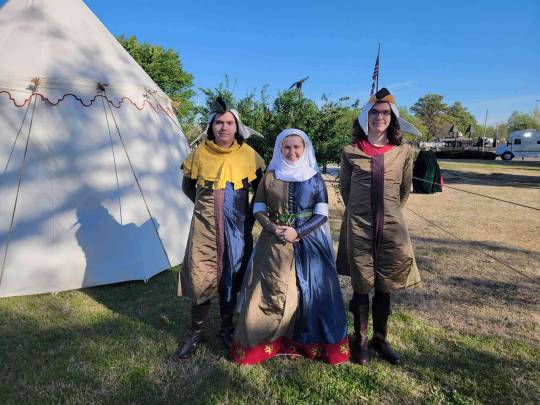
I had to accept that due to time constraints and a sum total of 1 hour to fit two people, my dreams of fully buttoned full length cotehardies would not be fulfilled. However, I am very satisfied with the way things turned out. My cuffs were long enough and sleeves snug enough to prevent riding up, and did not need the planned emergency Glamorgan chevronelly cuff. The mens' cotes were kept long (just below and just above the knee) for personal taste of the wearers. Both boys were put in hoods, though I seem to have failed to catch a picture with Thomas le Despencer in a hood. I have a habit of leaving my phone in the cast tent, so I am not surprised. The yellow dagged hood was my first foray into dagging and I am OBSESSED.
As both of the boys playing Edward and Thomas le Despencer were new to the historical costuming scene, neither were comfortable with the snug fit in the torso of a good cotehardie and requested an expansion to fit more like T-shirts. Due to the short time remaining, I opted to go for a stripe of dark brown linen down the front opening to ensure a semi-unified look. Unfortunately the literal last minute nature of this change resulted in some puckering down the front of each cotehardie that makes my eye twitch. I was terribly sad as this decision came after I'd installed what felt like thousands of buttonholes down the front of Edward's cotehardie.
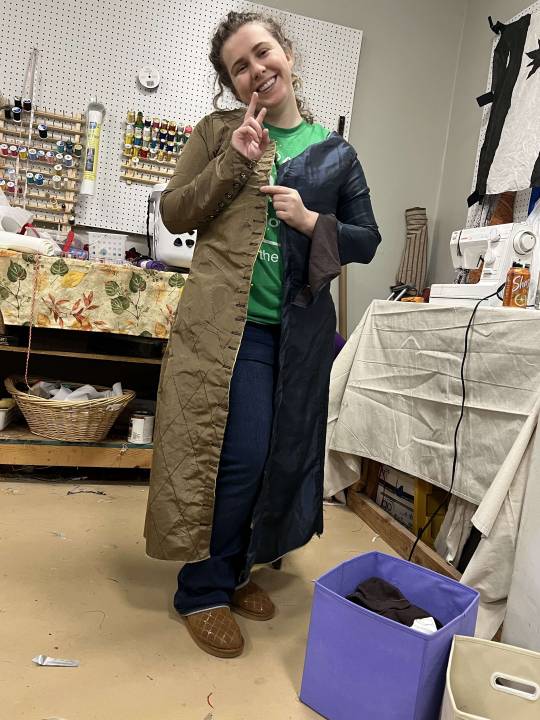
Alas, some concessions must be made for the hellish clash of the impending deadline of an event and the limited available time for fittings with students. I have very mixed feelings about the results of this project, as I feel I did not make these costumes up to my standards, but I am incredibly proud of what I managed with the restrictions and barriers I encountered.
Some highlights:
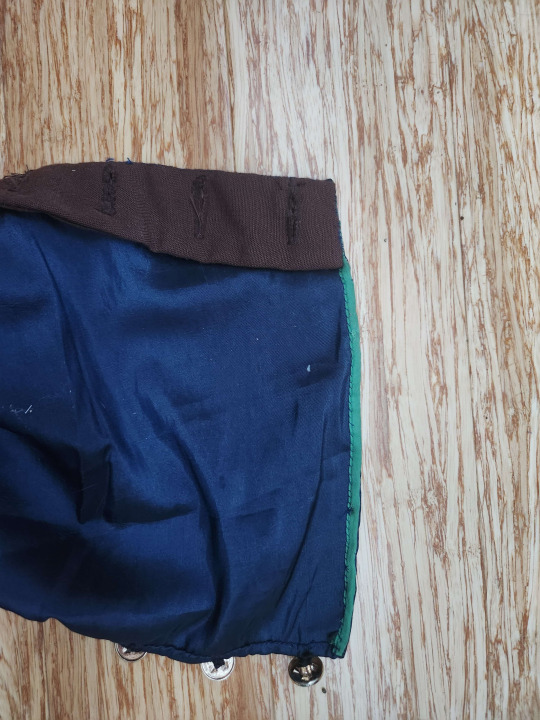
To maximize the length of the sleeve and reduce the bulk, I applied a piece of 3/8" polysatin bridal ribbon to the serged edge with the tiniest back stitches I've ever done, then folded the ribbon to the inside and whip stitched it in place to secure the edge and hide the serging. To prevent the thin satin from tearing where I applied my (machine) buttonholes, I took a scrap of linen, folded it in half, and applied it to the buttonhole edge as a facing to take the majority of the strain of the buttons off the fashion fabric.
At the suggestion of Countess Christyana at LPT, I made a long strip of craft felt to apply to the inside of my hem, backing the lions. I found this gave a body to the bronze and blue fabrics that they did not have previously, giving me a much better silhouette, as well as stiffened the edge of the dress and helpfully preventing me from tripping over my own two feet. I wore it with just the craft felt basted in to one dress rehearsal before applying a facing of scrap muslin to the interior edge. This encased the felt, preventing it from picking up every blade of grass in the state of Oklahoma.
Regrettably I have no pictures of the process of inserting the felt, but my process was simple. First, I applied the felt as a facing, turning it towards the interior edge. This I basted fairly loosely to the seam allowance where the red trim is attached to the bottom of the dress.
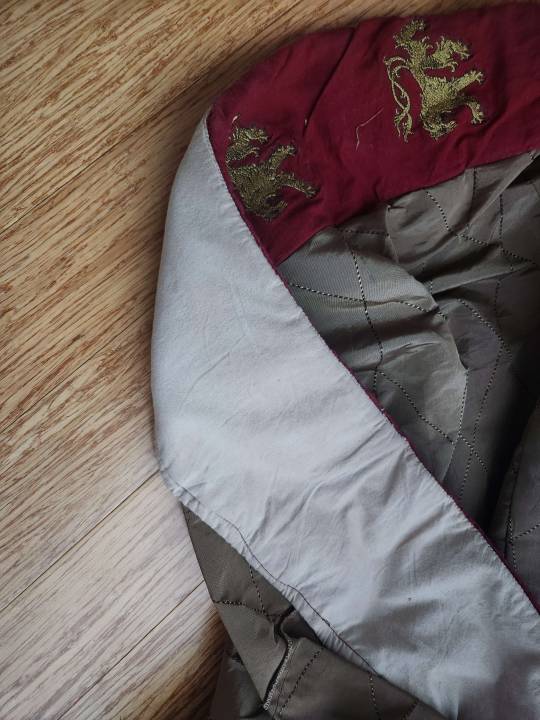
I then cleaned up the edge where the "grass guard" met the felt met the red embroidered band with some small whip stitches to give a crisp, clean finish.
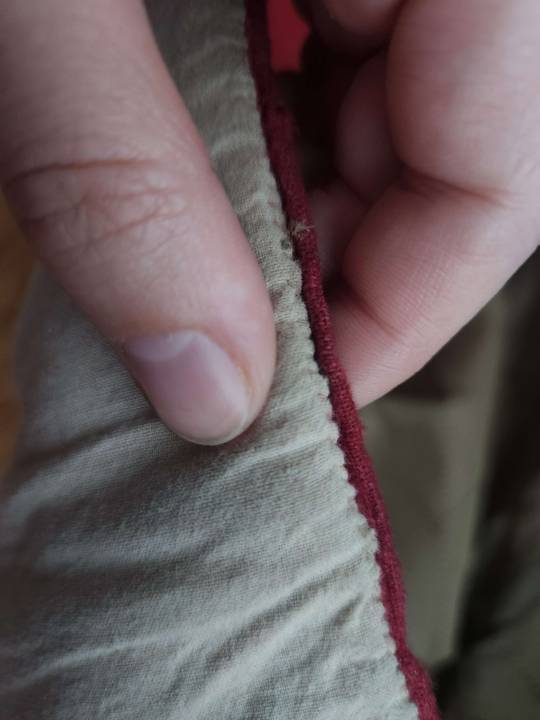
After three days in a variety of weather conditions, the interior lining did relax a little as seen below, and will require some cleanup.
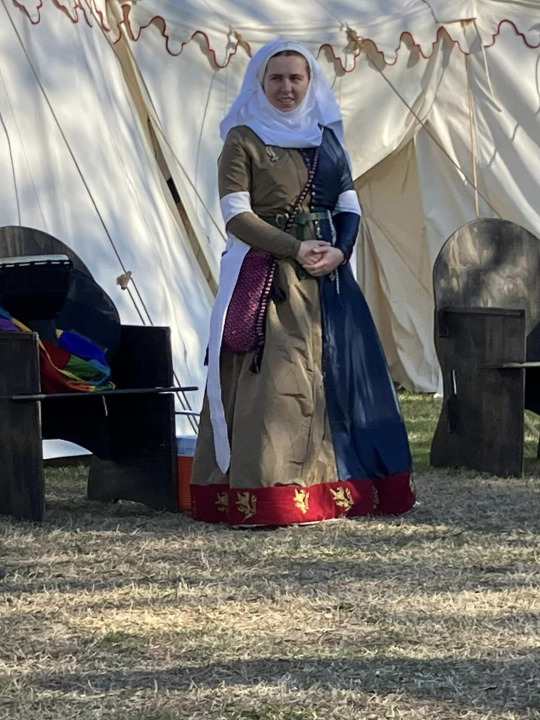
Pictured: Baroness Elizabeth Despencer attending the court of His Majesty Edward III, wondering why, exactly, one of the privateers has been handed the sword of state. (it was for a bit, we promise)
Also seen above, I purchased 14 badges of Prince Edward of Woodstock for the members of Prince Edward's Court (court 2) to wear, as a gift to the wonderful cast members who variously learned and developed new skills, stepped out of their comfort zones, and maybe let me turn them into human barbie dolls a little bit.
I really enjoyed wearing this outfit for three days through the course of the Norman Medieval Fair. I was incredibly worried about the polyester fabrics causing me to overheat, but found the linen lining and tight fitting torso prevented the polyester from building the dreaded heat pocket of humidity, and I stayed fairly cool and dry throughout the weekend. I found a personal preference for the structure and bulk of a wimple and veil when the face edges of both are folded, providing protection from the dust on the wind and the blazing sun. I cheated and safety pinned the bottom edge of my wimple together in the back, though the rest was secured by a single pin through the crossed upper edges to my brigitta cap and held tight by the pair of pins that attached my veil. Dancing in this garb made me feel more regal than I ever have in my life.
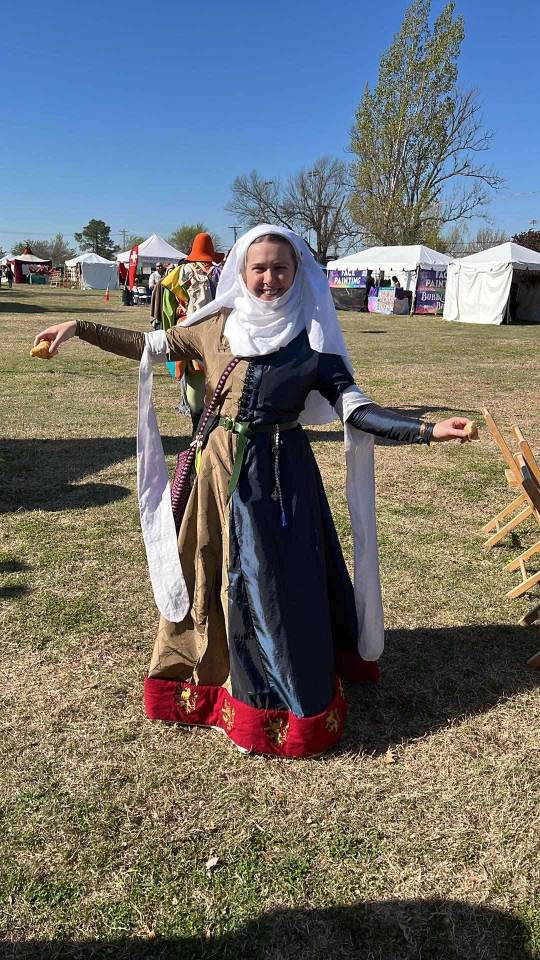
Pictured: a happy baroness with croissants. Fed nobility is happy nobility!
Unfortunately due to mental and physical health issues, I will not be returning as costuming director to the cast.
What comes next?
A klappenrock for a commission
Lesbian Minoan ;)
Coordinating Roman and Greek for myself and my consort
an attempt at a little viking cap!
a nap, probably.
#society for creative anachronism#historical costuming#historical reenactment#norman medieval fair#medieval#sca#arts & sciences#a&s#14th century#cotehardie#kirtle#medieval costuming#cote
11 notes
·
View notes
Text
182 Days of TPN - Day 59
Chapter 59: “Choose Your Weapon”
I really wanna know what what going on in WM’s head when he decided it was okay to hoard all sorts of weapons for children to use. Yeah it might not seem too bad for kids from Glory Bell & Grand Valley who could have older shipment ages than those from Grace Field, but still so dangerous. And I love it. But clearly the anime didn’t.
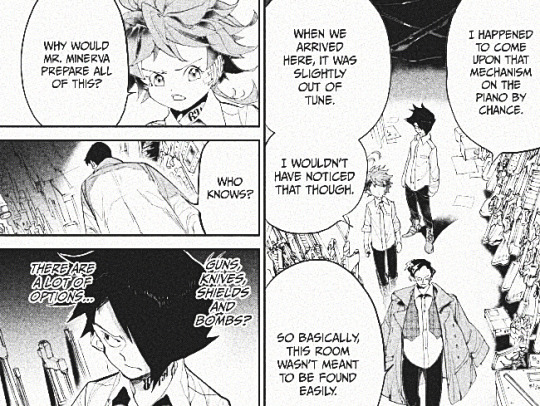
Do you wish to know what truly is heavy? All the sadness in my heart from never being able to see our best girl armed in season two. Bows & arrows are decent, but you can’t expect me to believe they fought through all those later arcs in that final ep slideshow with absolutely no fire power.

Naturally RE follow Sonju’s teachings in the upcoming chapters, but I also remembered Don follows this advice in ch138 as well.
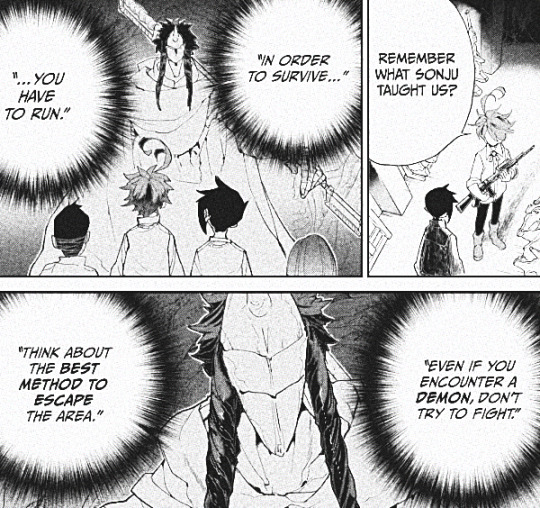
Bunker dad may not give them any pointers for choosing what weapons will suit them best, but they do pretty darn fine in figuring out what they’ll need and what will be helpful for them all on their own. Ray’s little thumbs up is precious.
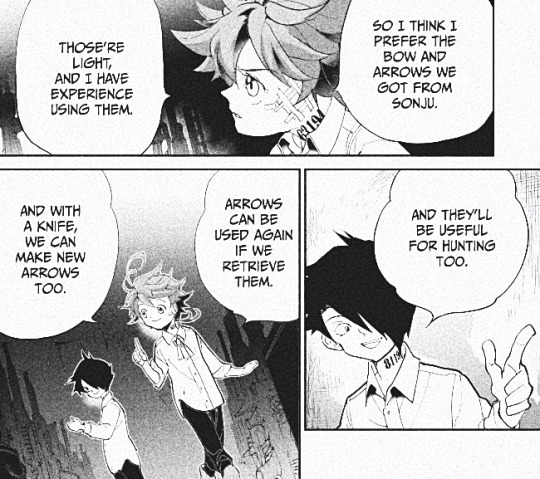
Please speak up Ray, I don’t think the anime heard you about only using bows & arrows. I was surprised up rereading this chapter just now that they also have a supply of shields, bombs and barbed wire, but even a medieval flail? This armory truly has everything imaginable. Again, nothing children should be using but eh, that’s where the fun comes in.

“Quite useful” is such an understatement! Take this! Hold onto it dearly! Never let it go! For it is a literal lifesaver!

The only mildly amusing part of this scene being cut from season two was seeing how confused anime-onlys reacted to see Ray’s ear in later episodes. Thinking he also cut his off like Emma did was a fair assumption I’ll admit, but she did clearly state in ep11 (with scalpel in hand) that she was just gonna remove his tracker. They actually had time to do so while Emma had to rush to remove hers between her fabulous performance and running away from Isabella and the burning house. Still sucks because we missed out on more medic Anna though. But aah, my boy, you need to stop giving such adorable smiles. I wanna pinch your cheeks.

Sigh, I seriously thought it was this panel the “Identity” OP was referencing the first time I saw it, even though it clearly shows Emma after the time skip (thanks to the hair clips). Still had a small hope they would’ve filled that empty space with Yuugo and not... Norman. (listening to the song again just now and can confirm that it still hits me with many emotions.. season two may have been a train wreck but the OP remains an absolute banger of a track).
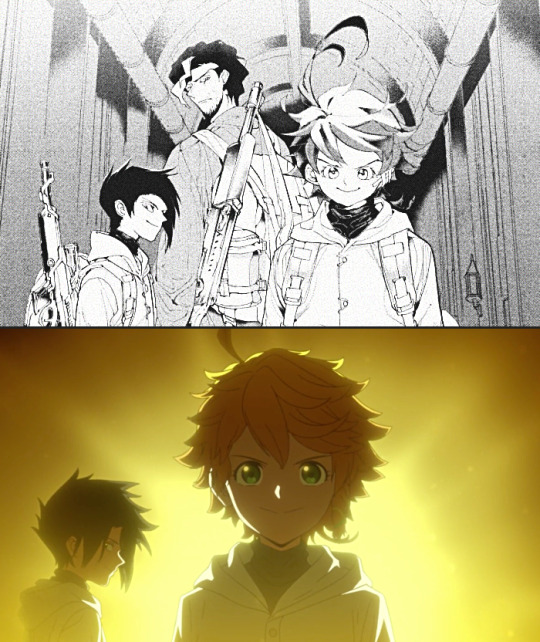
They care for her (and Ray) so damn much it makes me soft! AAHH! Especially the part about her not hiding any injuries to the point she collapses like she did in the demon’s forest. Poor Yuugo is so sick of all these mushy feelings. At least he’ll be away from it all for a couple days.
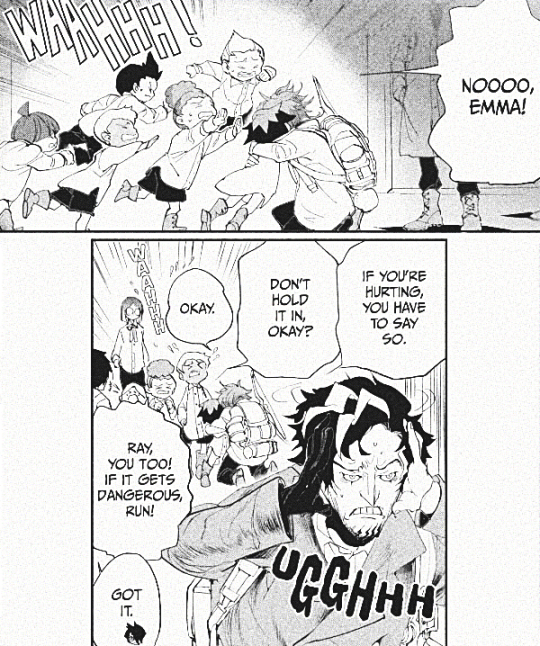
YESSS GILDA! Gotta say it’s one of my favorite moments of hers.. it’s just badass and the threat actually works! He’s absolutely terrified upon his return in ch96 because of how totally serious she was.
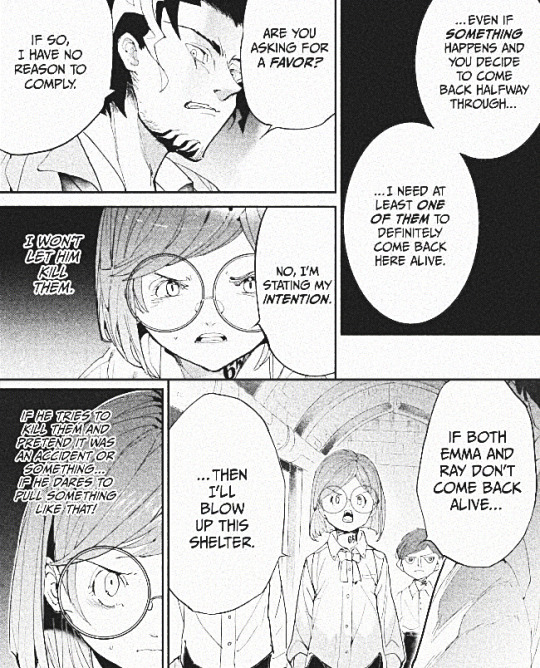
Favorite panel/moment:
BAZOOKA EMMA BAZOOKA EMMA BAZOOKA EMMA BAZOOKA EMMA BAZOOKA EMMA BAZOOKA EMMA BAZOOKA EMMA BAZOOKA EMMA BAZOOKA EMMA BAZOOKA EMMA

15 notes
·
View notes
Note
Happy WBW!
If your world has a main culture or religion, tell me about the people who DON'T believe in the same gods or culture. What groups are the minorities?
Hey friend! Thanks for the ask!
Incoming infodump because I spent sooooo much time on this oh my god.
WIPVII is basically just England in the early 1300s but slightly to the left. I did not want my story to fall into the trap of treating a pseudo-medieval England like a cultural and religious monolith because, of course, it gives the impression that real medieval England was a monolith and feeds into all sorts of bigoted revisionist history so...
I based the main religion heavily off of Catholicism because so many plot points in the story (around modesty, fidelity, marriage, women's roles etc.) rely on a very Christian-like status quo. The main culture is based off of the dominant Anglo-Norman culture in 1300s England. Of course, this makes it only fair that some other religions and cultures that also existed in 1300s England also get a shout out.
Ieuan is Cilfac and Udan, fictional cultures with similarities to Welsh and Jewish culture and religion respectively.
Uthman is multi-generational Cithic (which is the main ethnic group) but his ancestry is Idaluan, a fictional culture inspired by Muslim Al-Andalus (Spain). He still practices the religion of his ancestors too.
Henry has a grandmother from Lyzviria, similar to the Byzantine Empire (mainly Greek at this time). From her he gets his complexion, still pale-skinned because she came from royalty but with golden undertones rather than pink, and hair with dark, loose curls.
Matilda's father is from Para, a fictional city resembling Jerusalem. I never decided which religious group he belongs to but never comes up. Matilda was raised by her Cithic-Andovin mother, aunt, and uncle and practices the dominant religion.
There is also a more minor character (though arguably the most important after the pro- and antagonists themselves as far as plot is concerned) named Tamas of Mairan. Tamas is a seafaring mercenary/pirate who commands a multi-ethnic crew. He himself is from Torsia, which is inspired by Persia during Mongol conquest.
There are also a few other ethnicities that aren't dominant but... our modern lens see them all as white people whereas the distinctions are important to the people in this world.
Some context:
The Andovins are inspired by the Normans. The Pylts are inspired by the Anglo-Saxons (who, in 1333, had mostly integrated with the conquering Norman culture to become the Anglo-Normans, but some remote vestiges likely remained). The Cithic people are like to the Anglo-Normans, mostly common people with Piltish ancestry. The Cithic-Andovins are the upper-class, the rulers of Cithidy who are technically Cithic because they are from Cithidy but have much more in common, including the Andovaic language, with the Andovins than with the Cithics they rule over. There is also an ethnic group called the Diacs who live in northeastern Dian (it is from them the kingdom gets its name); this group is representative of the Celtic Bretons who came with the Normans to England in 1066. And I mentioned the Cilfacs already too.
This makes the two dominants groups the Cithics and the Cithic-Andovins. The Cithics are the majority group and make up the urban class of merchants, craftsmen, and clergy in most regions of Cithidy and Dian. The Cithic-Andovins are the ruling class that conquered Cithidy and Dian. They share a religion with the Cithics but not a language, and there are cultural differences. They are minority but comprise most of the noble families.
The Cilfacs and the Diacs follow a religion based on Celtic Christianity. The Pylts technically share a religion with the Cithics and Andovins, but they have some unique saints and traditions carried over from pagan times (although that was 600 years ago.)
As mentioned Ieuan is both Cilfac and Udan. He had a Cilfac parent, and a parent who was also Cilfac-Udan. In terms of his religious practices, he tries to honour both traditions in his own way.
Alan is Diac.
Wulfrith identifies more as Piltish than he does Cithic. Where he is from they still speak a dialect of the old Piltish tongue rather than the new Cithic one. The difference is like the difference between Old and Middle English (aka. Anglo-Norman). In fact, I cheated and just used Old English words for anything named in the Piltic language. Pilitish itself comes from pyll + cythu, the Old English words for inlet and homeland. Cithic is also derrived from cythu.
Though to be fair, I did that with more than just Old English. Wulfrith is an Anglo-Saxon name. Alan is a Breton one. Tamas is a name contemporary to 1300s Persia, and Uthman an Islamic name used in 1300s Al-Andalus. Ieuan is a Welsh name. Dian and Diac derrive from the Breton word diazac which means land that drains into a river. Cilfac is the Welsh word for creek.
so uh yeah... I hope you enjoyed my info dump!
8 notes
·
View notes
Note
I love your opinions on romance novels! I have such an affection for them. Do you have any recommendations for f/f romance, especially if it’s a little crazy or intense? I feel like it’s often more toned down/tame than m/f and m/m :( anyway thank you!
Thank you! That's very kind to say.
I have noticed the same issue with F/F. I'm not sure why that is--there's an obvious issue with F/F not being as represented in general in romance as M/F or M/M, and then out of that smaller group a lot of it either feels just naturally lighter or... Almost afraid of going there? I do think sometimes that there's a concern re: queer romance that if you delve into the kind of twistedness and toxicity more often seen in M/F, you'll normalize some bad stereotypes. Which is a risk, sure, but it doesn't seem fair to me that there's a heavier scrutiny on queer romance--or F/F in particular, because M/M can get away with it more often. And that's because M/M is fetishized by the straight female readership, imo.
Anyway, for F/F I obviously love Samara Breger's A Long Time Dead, which is for sure one of the more wild, intense sapphic romances I've read. Gotta love queer vampires!
Generally I will say that Sierra Simone goes there a bit more.
Thornchapel Quartet by Sierra Simone--There are two romantic relationships in the series, both of which get a lot of page time. One is a MMF triad, the other is Rebecca/Delphine, a FF couple. Rebecca is a very confident, self-assured, and withholding domme; Delphine is a traumatized, sheltered, and spoiled model who is originally engaged at the beginning of the first book, but has no physical intimacy with her fiancee. (Heads up: Delphine was raped in the past, and this is something she confronts a lot over the course of the series. There is no on the page SA in the series, but discussions of what happened to her.) They originally have a lot of angry (on Rebecca's side) relationship, then start hooking up, then start falling in love while also engaging in BDSM. And dealing with an ancient, dark mystical force threatening them and their friends. Their relationship is intense and complex and they both make big mistakes and there's a ton of angst, and the plot is generally insane. I will say--it's Sierra Simone, everyone is bisexual, everyone hooks up with each other, ESPECIALLY in this series. Generally, Delphine and Rebecca largely sleep with each other, but the first big "orgy" scene in the series is Delphine and another woman being directed by Rebecca, and they both have briefer encounters with other people in other group sex scenes. Generally, however, their major encounters are with each other and they are only IN LOVE with each other.
The Fae Queen's Captive by Sierra Simone--Ooh, this one is short but good. The main heroine is a mortal kidnapped by the fae, and she's taken to become the (temporary) consort of the mysterious and powerful fae queen. Dark, wild, intense, bloody. Heads up: again, Sierra Simone, so the first sex scene is the heroine having sex with two other people while the queen observes, and there is another scene wherein the heroine is instructed to pleasure another woman in front of the queen.
The Conquering of Tate the Pious by Sierra Simone--A medieval novella about the abbess of a.... unique... convent, who ends up clashing against a Norman conqueror, who actually turns out to be a woman who took over her dead husband's forces. This was originally published in the Villain I'd Like to F... collection (which is no longer available for sale, but some libraries have it) and it's a villain romance with all that implies. So good.
Mortal Follies by Alexis Hall--This is more on the whimsical side, but it is high stakes and intense. It's set in this world that's like... Much Ado About Nothing x Jane Austen, and the one heroine meets the other after a hex is put on her that causes her dress to begin unraveling at a ball. The other heroine is this very dark, mysterious woman who's rumored to have killed her father and brother. There's a good deal of angst in their relationship, lives are threatened, it's very well done.
An Island Princess Starts a Scandal by Adriana Herrera--Not dark, but a dramatic historical romance about a Caribbean heiress who approaches an experienced businesswoman (who wants to acquire something from the heiress) and offers to strike a deal with her if the businesswoman shows her the joys of 1800s lesbian Paris. Initially, that's supposed to be the general joys, but, you know. It turns into sex.
Mistakes Were Made by Meryl Wilsner--A lighter contemporary, but does have higher stakes and a bit of zaniness because it begins with the main girl hooking up with an older woman in a parking lot... Only to discover that the older woman is her new friend and college roommate's MOM.
Cleat Cute by Meryl Wilsner--Again, lighter, but still has stakes and passion. The heroines are both elite soccer players aiming for the Women's National Team/World Cup, and they begin casually hooking up on the low. This one deals a lot with neurodivergence--one of them has ADHD, and the other one is on the spectrum. It also has the implications of hooking up on the team, sneaking around, one being so sparkly while the other withholds emotionally. It's good.
I hope you like some of these!
5 notes
·
View notes
Text
I know absolutely ZERO about this movie,but I am 110% certain that guy in the hat spent- and spends- every first weekend of April at the Norman Medieval Faire.




Twister (1996)
1K notes
·
View notes
Text
Holidays 4.4
Holidays
Antitrust Day
Arrestmas
Art Deco Day
Atlanta Day
Auditory Processing Disorder Awareness Day
Ballroom Dance Day
Basque Day (Spain)
Bewitching Day
Bonza Bottler Day
Calypso Asteroid Day
Chicago Flag Day (Illinois)
Children’s Day (China, Taiwan)
Clear and Bright Day (Farmer’s Calendar; China)
Day of (No) Silence
404 Day
Grand National Ladies Day (UK)
HIE Awareness Day
Hug a Newsperson Day
International Day for Mine Awareness and Assistance in Mine Action (UN)
International Day to Defend Amina
International Rock Beat Day
Jeep 4x4 Day
Kids’ Yoga Day
Liberation Day (Hungary)
Maya Angelou Day (Boston)
Microsoft Day
Mourning Day for Covid-19 Martyrs (China)
National Lunchbreak Day (UK)
National Picky Eaters Day
National School Librarian Day
NATO Day
1984 Day (1984)
Ose Matsuri (Japan)
Peace Day (Angola)
Primary Progressive Aphasia (PPA) Awareness Day
Refugee Rights Day (Canada)
Sarhul (Jharkhand, India)
Square Root Day
Swedish-American Friendship Day
Tell-A-Lie Day
Victims of Violence Wholly Day
Vitamin "C" Day
Walk Around Things Day
Women in Tech Day
World Drummers Day
World Plagiocephaley Day
Yukon Gold Discovery Day
Food & Drink Celebrations
Chocolate Milk Powder Day (a.k.a. Powdered Chocolate Day)
Day of Pho (Vietnam)
Homogenized Milk Day
International Carrot Day
National Cordon Bleu Day
National Pub Day (UK)
National Ramen Noodle Day
Nature Celebrations
Bee Day (French Republic)
Cat’s Day (Taiwan)
International Carrot Day
National Horse Rehabilitation Day
National Pansy Day
Red Crown Imperial Day (Fritillary Imperialus)
World Rat Day
World Stray Animals Day
Independence, Flag & Related Days
Chinese Republic in Tibet (Proclaimed; Tibet; 1912)
Flag Act of 1818 (US; 1818)
Flag Day (Chicago, Illinois; Monaco)
Jacktoopia (Declared; 2014) [unrecognized]
Senegal (from France, 1960)
Sorrenia (Declared; 2013) [unrecognized]
1st Friday in April
Bandcamp Friday [1st Friday]
Comfort Food Friday [Every Friday]
Fast Food Friday [1st Friday of Each Month]
Five For Friday [Every Friday]
Flashback Friday [Every Friday]
Freaky Friday [1st Friday of Each Month]
Friday Finds [Every Friday]
Fry Day (Pastafarian; Fritism) [Every Friday]
Hospital Admitting Clerks Day [1st Friday]
International Infection Preventionist Day [1st Friday]
International Kids Yoga [1st Friday]
National Volleyball Day [1st Friday]
National Walk to Work Day [1st Friday]
National Wear Blue Day for Child Abuse Prevention [1st Friday]
Orphan’s Day (Egypt) [1st Friday]
Poet in a Cupcake Day [Friday of 1st Full Week]
Student Government Day [1st Friday]
Texas Fruit & Vegetable Day (Texas) [1st Friday]
TGIF (Thank God It's Friday) [Every Friday]
Weekly Holidays beginning April 4 (1st Week of April)
Hate Week (thru 4.10)_
National Dental Hygienist Week (thru 4.10)
Sherlock Holmes Weekend (thru 4.6)
Spring SF Restaurant Week (San Francisco, California) [thru 4.13]
Festivals On or Beginning April 4, 2025
American Crossword Puzzle Tournament (Stamford, Connecticut) [thru 4.6]
Boudin Festival (Scott, Louisiana) [thru 4.6]
Decibel Magazine Metal & Beer Fest: Philly (Philadelphia, Pennsylvania) [thru 4.5]
International Orange Blossom Carnival (Adana, Turkey) [thru 4.13]
Lake County Fair (Eustis, Florida) [thru 4.13]
Medieval Fair (Norman, Oklahoma) [thru 4.6]
North Texas Gourd Festival (Dripping Springs, Texas) [thru 4.5]
OBX Taste of The Beach (Outer Banks, North Carolina) [thru 4.6]
Pennsylvania Herb & Garden Festival (York, Pennsylvania) [thru 4.5]
Pig Cookin' Contest (Newport, North Carolina) [thru 4.5]
Tater Days (Benton, Kentucky) [thru 4.7]
Wine Forum of Oklahoma (Stillwater, Oklahoma) [thru 4.5]
Feast Days
Aequinoctium Vernum VI (Pagan)
Agathopus and Theodulus (Christian; Martyrs)
Ambrose (Christian; Saints Commemoration)
Benedict the Moor (Christian; Saint)
Dabucuri pataub, (Initiation Rites of the Young Men; to Jurupari, South American Guarani/Tupi God)
Feast of No Saints Day (Pastafarian)
Gaetano Catanoso (Christian; Saint)
Isidore of Seville (Christian; Saint)
The Kangaroo Rat (Muppetism)
Katori Jingu Otaue-sai (Rice Planting Festival; Japan)
Magna Mater begins (aka Megalesia / Great Mother Festival; Ancient Rome)
Martin Luther King Jr. (Episcopal Church (USA))
Megalesia (Mother of Gods Festival; Phrygian)
Mahavir Jayanti (a.k.a. Janma Kalyanak; Jainism)
Näfelser Fahrtfest (Glarus Canton, Switzerland)
Plato (Christian; Saint)
Portfirio Diaz Day (Church of the SubGenius; Saint)
Reginald Heber (Anglican Church of Canada)
Theodisius of Bithynia (Positivist; Saint)
Tigernach of Clones (Christian; Saint)
Tomb Sweeping Day (掃墳節) [Begins At the Qingming solar term, solar longitude of 15°, 15th days after Chunfen] (a.k.a. …
Ancestors' Day
Cheng Ming (Macau)
Chinese Memorial Day
Ching Ming Festival (清明節; China; Hong Kong)
Chungmyung Day (North Korea)
Clear and Bright Festival
Qingming Jie (清明节; China)
Qingming Festival
Shīmī (Ryukyu Islands)
Tomb Sweeping Day (Taiwan)
Lunar Calendar Holidays
Chinese: Month 3 (Geng-Chen), Day 7 (Gui-Mao)
Day Pillar: Water Rabbit
12-Day Officers/12 Gods: Close Day (閉 Bi) [Inauspicious]
Holidays: Tomb Seeping Day / Qing Ming Jie holiday
Secular Saints Days
Maya Angelou (Literature)
David Cross (Entertainment)
Remy de Gourmont (Literature)
Maurice de Vlaminck (Art)
Robert Downey Jr.
Marguerite Duras (Literature)
Edward Hicks (Art)
Gil Hedges (Sports)
Cloris Leachman (Entertainment)
Heath Ledger (Entertainment)
Italo Mus (Art)
Monty Norman (Music)
Graham Norton (Entertainment)
Margaret Oliphant (Literature)
Joe Orlando (Art)
Barry Pepper (Entertainment)
Anthony Perkins (Entertainment)
Pierre-Paul Prud´hon (Art)
Thomas Mayne Reid (Literature)
Eric Rohmer (Entertainment)
Robert E. Sherman (Literature)
Alicia Silverstone (Entertainment)
Dan Simmons (Literature)
Tris Speaker (Sports)
Muddy Waters (Music)
Hugo Weaving (Entertainment)
Lucky & Unlucky Days
Sakimake (先負 Japan) [Bad luck in the morning, good luck in the afternoon.]
Unluckiest Day of the Year (China)
Premieres
Alice’s Auto Race (Disney Cartoon; 1927)
Aloha From Hawaii, by Elvis Presley (TV Concert Special; 1973)
Anna Karenina (Film; 1997)
The Blow-Out (WB LT Cartoon; 1936)
Bobby Bumps (Paramount Magazine Cartoon; 1920)
Brilliant Corners, by Thelonius Monk (Album; 1957)
The Bum Bandit (Fleischer Talkartoon Cartoon; 1931)
Bye Bye Birdie (Film; 1963)
Captain America: The Winter Soldier (Film; 2014)
Cat Carson Rides Again (Noveltoons Cartoon; 1952)
Chasing Amy (Film; 1997)
Combatants Will Be Dispatched (Anime TV Series; 2021)
Cool for Cats, by Squeeze (Album; 1979)
Cowboy Bebop: The Movie (Anime Film; 2003)
Dipsy Gypsy (Madcap Melody George Pal Cartoon; 1941)
Dixie, by Daniel Emmett for Bryan’s Minstrels (Song; 1859)
The Double (Film; 2013)
Drum Roll, featuring Hector Heathcote (Terrytoons Cartoon; 1961)
Felix the Cat Uses His Head (Felix the Cat Cartoon; 1926)
Fiesta Time (Color Rhapsody Cartoon; 1945)
Finnegan’s Flea (Noveltoons Cartoon; 1958)
Flies Ain’t Human (Fleischer Popeye Cartoon; 1941)
Follies, by Stephen Sondheim (Broadway Musical; 1971)
Fowl Weather (WB MM Cartoon; 1953)
The Good Life, a.k.a. Good Neighbors (UK TV Series; 1975)
Heap Big Hepcat (Woody Woodpecker Cartoon; 1960)
High Fidelity, by Elvis Costello (Song; 1979)
Housing Shortage (Aesop’s Film Fable Cartoon; 1925)
How Right You Are, Jeeves (a.k.a. Jeeves in the Offing), by P.G. Wodehouse (Novel; 1960) [Jeeves #12]
Indian Pudding (Terrytoons Cartoon; 1972)
Jacobs Field, in Cleveland, Ohio (Sports Stadium; 1994)
Joe Boko (Canimated Pictorial #8 Wallace Carlson Studio Cartoon; 1916)
Jonny’s Golden Quest (Hanna-Barbera Animated TV Special; 1993)
The King of Beasts (Unnatural History Cartoon; 1926)
Lambert the Sheepish Lion (Disney Cartoon; 1952)
Leatherheads (Film; 2008)
Make Me Smile, by Chicago (Song; 1970)
Man’s Best Friend (Disney Cartoon; 1952)
Microsoft (Computer Company; 1975)
Mississippi Queen, by Mountain (Song; 1970)
The Mouse That Jack Built (WB MM Cartoon; 1959)
Mutts About Racing (Droopy MGM Cartoon; 1958)
NATO (Treaty Organization; 1949)
Nim’s Island (Film; 2008)
Oliver’s Story, by Erich Segal (Novel; 1977)
The Party (Film; 1968)
Perils of Pauline (Film Series; 1914)
Pink Quackers (Pink Panther Cartoon; 1979)
Pluto’s Surprise Package (Disney Cartoon; 1949)
Portrait of the Artist as a Young Dog, by Dylan Thomas (Short Stories; 1940)
Rio Bravo (Film; 1959)
The Saint (Film; 1997)
Second, by Midori (Album; 2007)
Ship of the Line, by C.S. Forester (Novel; 1938)
Suffering’ Sasquatch (WB Cartoon; 2002)
Swiss Movements (Krazy Kat Cartoon; 1931)
Toro Pink (Pink Panther Cartoon; 1979)
Two Little Pups (Happy Harmonies Cartoon; 1936)
Ups ’n Downs (WB LT Cartoon; 1931)
What a Girl Wants (Film; 2003)
Today’s Name Days
Isidor, Konrad (Austria)
Benedikt, Izidor, Platon (Croatia)
Ivana (Czech Republic)
Ambrosius (Denmark)
Ambrus, Arbo, Arp, Arpo (Estonia)
Ukko (Finland)
Isidore (France)
Isidor, Konrad, Kurt (Germany)
Izidor (Hungary)
Isabelle, Isadora, Isidoro (Italy)
Herta, Valda (Latvia)
Algaudas, Ambraziejus, Eglė, Izidorius (Lithuania)
Nancy, Nanna, Nina (Norway)
Ambroży, Bazyli, Benedykt, Izydor, Wacław, Wacława, Zdzimir (Poland)
Iosif (Romania)
Izidor (Slovakia)
Benito (Spain)
Ambrosius, Marianne, Marlene (Sweden)
Cedric, Cedrica, Plato, Tiernan, Tierney (USA)
Today’s National Name Days
National Dillon Day
Today is Also…
Day of Year: Day 94 of 2025; 271 days remaining in the year
ISO Week: Day 5 of Week 14 of 2025
Celtic Tree Calendar: Fearn (Alder) [Day 18 of 28]
Chinese: Month 3 (Geng-Chen), Day 7 (Gui-Mao)
Chinese Year of the: Snake 4723 (until February 17, 2026) [Ding-Chou]
Coptic: 26 Baramhat 1741
Druid Tree Calendar: Rowan (April 1-10) [Day 4 of 10]
Hebrew: 6 Nisan 5785
Islamic: 5 Shawwal 1446
Julian: 22 March 2025
Moon: 46%: Waxing Crescent
Positivist: 10 Archimedes (4th Month) [Theodisius of Bithynia]
Runic Half Month: Ehwaz (Horse) [Day 6 of 15] (thru 4.9)
Season: Spring (Day 15 of 92)
SUn Calendar: 5 Cyan; Fryday [5 of 30]
Week: 1st Week of April
Zodiac:
Tropical (Typical) Zodiac: Aries (Day 15 of 30)
Sidereal Zodiac: Pisces (Day 21 of 30)
Schmidt Zodiac: Pisces (Day 15 of 26)
IAU Boundaries (Current) Zodiac: Pisces (Day 24 of 38)
IAU Boundaries (1977) Zodiac: Pisces (Day 24 of 38)
0 notes